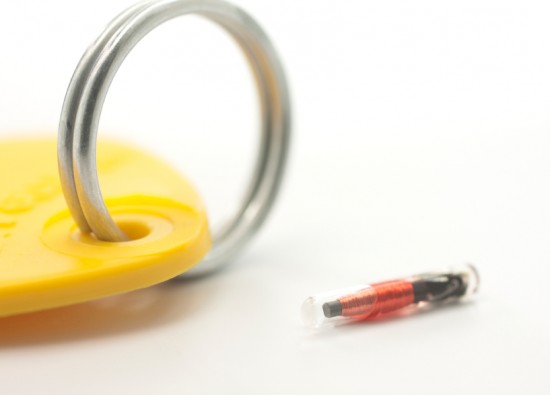

Each year thousands upon thousands of pets go missing usually through no fault of their owners. It could be a postman or child leaving the gate open or maybe a dog chasing after a squirrel on a walk. Whatever the reason the good news is that a large percentage of missing pets are reunited with their worried owners relatively quickly but sometimes their journey back home may take days, weeks, months or even years. It may be the case that they are never found again. There is one thing you can do to give your pet the best possible chance of getting back to you quickly and safely though, microchipping them. When a stray pet is picked up by the RSCPA or another animal organisation the first thing they'll check to find out the owners identity is a tag on the animals collar. Failing that they will then scan for a microchip and trace the owner that way. Without either a collar or microchip, tracing the owners is made much more difficult, if not impossible.
A microchip is a tiny electronic capsule which is roughly the size of a grain of rice commonly used for identifying dogs and cats, but may also be implanted in other animals such as horses, parrots and small furries. The microchip is made from an inert material such as soda lime glass which ensures that the animal will not be adversely affected by the presence of the chip in their body. The chip doesn't contain a power source and they are only activated when they are acted upon by a scanner and as a result they will easily last through the lifetime of your pet. The chip is implanted into the animal using a needle and is carried out by a vet or other suitably qualified person. The microchip is usually inserted below the skin at the back of the neck, between the shoulder blades on the dorsal midline in both dogs and cats.
Each microchip contains a unique identification number which can only be read using a microchip scanner. This number can be matched to records kept on a database such as the national PetLog database in order to find out the contact details of the owners.
The procedure for microchipping a pet is incredibly short and relatively painless and there is no sedative or anesthetic required. The whole thing will be over in a matter of minutes, with the pain that the animal experiences being similar to having a injection. How any individual pet reacts will vary and some pets may flinch or yelp, while others will not react at all. To make the procedure as safe as it can possibly be it is best to have it carried out by a qualified veterinarian.
Micro-chipping is one of the safest procedures an animal can have and it is incredibly rare for complications to arise from a pet being micro-chipped. However, as with all medical procedures, there is a minimal risk which can be reduced by having it carried out by a qualified vet.
There have been studies that suggest a slight increased risk of cancer in animals that have been micro-chipped, however it should be stressed that millions of pets have micro-chips implanted every year with no ill effects. When you weigh this tiny risk against the enormouss benefits, it is clear that having your pet micro-chipped is the best decision all round.
If you go to the vets specifically to have your pet micro-chipped it will likely cost between £20 and £30, however if you have it done along with another procedure such as routine injections, then it may cost less. If you will struggle to afford this then it may be worth contacting animal charities in your area, as they often offer microchipping for a fraction of the cost.
If you move house or your phone number changes then it is important to update the information on the microchip immediately. How you do this depends on which registry your pets information is stored on, such as the Petlog database. Nowadays it is possible to change the information online or you can do it by post, however there is usually a small fee to pay to update the details.
If you purchase a pet that already has a micro-chip implanted then it is essential that you acquire the micro-chip registry details/ownership forms from the previous owner. Without them it can make altering the details much more complicated. If you adopt a dog or cat from a rescue centre then they will be able to sort this out for you.
Currently it is required that a dog have a collar and tag in public but it is not compulsory for a pet to be micro-chipped. This is being reassessed by the government at the moment. Whether the law changes on this subject or not, it is essential that owners take the responsibility of micro-chipping their pet into their own hands.
 Vulnerable Uk Native Dog Breeds - The Terrier Group
Vulnerable Uk Nat
Vulnerable Uk Native Dog Breeds - The Terrier Group
Vulnerable Uk Nat
 Why First Dog Bo Obama Matters
The US public has been kept in the dark about the new White
Why First Dog Bo Obama Matters
The US public has been kept in the dark about the new White
 Consider a House Bunny for Your Next Pet
Consider a House Bunny for Your Next Pet
 How to work for or open a dog boarding of your own?
How to work for or open a dog boarding of your own?
How to work for or open a dog boarding of your own?
How to work for or open a dog boarding of your own?
 Blue Fronted Amazon
Blue Fronted Amaz
Blue Fronted Amazon
Blue Fronted Amaz
Copyright © 2005-2016 Pet Information All Rights Reserved
Contact us: www162date@outlook.com